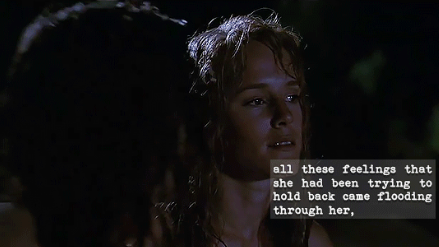
A Moment Outside the Church Walls
Set against the lush backdrop of the Alabama wilderness, the river baptism scene in Fried Green Tomatoes stands out as one of the film’s most quietly profound and emotionally layered moments. It is not a loud or dramatic event. There is no fire, no confrontation. Instead, there is water, light, and a sense of sacred stillness.
Ruth Jamison, newly arrived in Whistle Stop and still emotionally tethered to a life of rigid rules and religious tradition, has come to the river with the local church group. It is an act of both spiritual renewal and social conformity—a public expression of faith in a town where religion is an essential thread of communal life.
Idgie Threadgoode, wild and unchurched, stands on the riverbank, watching from a distance. She is not part of the ceremony, nor is she dressed for it. Her posture is casual, almost defiant. But her eyes—sharp, attentive, and uncertain—betray an emotional undercurrent that belies her tough exterior.
The Distance Between Them
This moment crystalizes the emotional and ideological space between Idgie and Ruth. Ruth, raised in tradition, believes in formal rituals. She sees the river baptism as a chance to cleanse her soul and perhaps bring structure back into her life, after the recent trauma of her father’s death and her growing feelings for Idgie.
Idgie, in contrast, rejects all systems that seek to control her—religion, society, gender roles. She scoffs at the idea that someone needs a preacher’s blessing to be whole. But her mocking demeanor hides something deeper: fear. Fear that Ruth, by participating in this ceremony, is slipping away into a world that doesn’t have room for someone like Idgie.
As the congregation sings, Ruth wades into the river, her white dress floating around her like a ghost’s shroud. The preacher, with gentle solemnity, leans her back into the water and lifts her again—symbolically washed, spiritually born anew.
Idgie’s expression doesn’t change, but her eyes glisten.
Faith Reimagined in a Glance

After the baptism, as Ruth returns to the bank, dripping and reborn, she looks directly at Idgie. It is not a look of triumph, or righteousness—it is a silent invitation.
Without words, Ruth says: I know who you are. I saw you there. And I’m still with you.
Idgie doesn’t speak. She just nods, once, barely. But in that single gesture, something monumental passes between them. It is not religious in the traditional sense. It is a covenant of their own making.
Here, faith is no longer tied to church hymns or river rituals. It becomes something quieter, deeper—an unspoken trust between two women who are learning how to meet each other in the space between fear and hope.
Symbolism Beneath the Surface
The river in this scene is more than a setting; it is a character. Rivers have long symbolized transformation and the passage from one life phase to another. For Ruth, this baptism is a symbolic shedding of her past—her abusive marriage, her guilt, her fears. She is stepping into her future with Idgie, even if she can’t yet name what they are to each other.
For Idgie, the river is a boundary. One she does not cross—not literally, not figuratively. But watching Ruth cross it doesn’t alienate her; it opens the possibility of reconciling their differences. The river becomes a place not of separation, but of connection.
In many ways, the scene rewrites the meaning of baptism. It’s no longer just a religious act—it’s an emotional declaration: “I’m ready to begin again. I’m not alone.”
Ruth’s Quiet Defiance
Although Ruth never confronts the church directly, her choice to make this baptism part of her journey with Idgie is quietly subversive. She is not performing purity for the town’s approval. She is claiming a ritual of renewal for herself, on her own terms.
And importantly, she shares it with Idgie—not by bringing her into the ceremony, but by making her witness. She allows Idgie to see her vulnerability, her belief in something greater, and her desire for peace. That act of exposure is an offering. It is Ruth’s way of saying, “I trust you with this part of me.”
A Turning Point in Their Bond
After the baptism, their relationship shifts. Ruth begins to shed her internal restraints, allowing herself to laugh more freely, to challenge Idgie’s bravado with her own strength. Idgie, in turn, softens. She becomes more protective, more openly affectionate. The river scene has baptized them both—not with water, but with understanding.
This mutual recognition is what makes their bond feel sacred, even without the labels others might demand. They are not bound by vows or doctrine. They are bound by love, forged in everyday choices, and baptized not in church, but in the waters of their shared experience.
Conclusion: A Baptism of Mutual Faith
The river baptism scene in Fried Green Tomatoes is easy to overlook, but it contains the film’s spiritual core. In it, faith is redefined—not as allegiance to religion, but as devotion to another human being.
Ruth is not saved by water. Idgie is not lost for staying dry. They both find something holier: a moment of truth that transcends rules and embraces authenticity.
Their love, their friendship, their partnership—whatever name the world insists on giving it—is baptized in the silent agreement that they will walk forward together, in belief, in courage, and in quiet, unbreakable faith.
